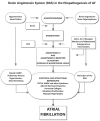The Role Of Renin Angiotensin System In Atrial Fibrillation
- PMID: 27957054
- PMCID: PMC5135231
- DOI: 10.4022/jafib.972
The Role Of Renin Angiotensin System In Atrial Fibrillation
Abstract
Atrial fibrillation (AF) is the most prevalent arrhythmia and its incidence is on the rise. AF causes significant morbidity and mortality leading to rising AF-related health care costs. There is experimental and clinical evidence from animal and human studies that suggests a role for the renin angiotensin system (RAS) in the etiopathogenesis of AF. This review appraises the current understanding of RAS antagonism, using angiotensin converting enzyme inhibitors (ACE-I), angiotensin receptor blockers (ARB) and aldosterone antagonists (AA), for prevention of AF. RAS antagonism has proven to be effective for primary and secondary prevention of AF in subjects with heart failure and left ventricular (LV) dysfunction.However, most of the evidence for the protective effect of RAS antagonism is from clinical trials that had AF as a secondary outcome or from unspecified post-hoc analyses. The evidence for prevention in subjects without heart failure and with normal LV function is not as clear. RAS antagonism, in the absence of concomitant antiarrhythmic therapy, was not shown to reduce post cardioversion AF recurrences. RAS antagonism in subjects undergoing catheter ablation has also been ineffective in preventing AF recurrences.
Keywords: Aldosterone Antagonists; Angiotensin Converting Enzyme- inhibitors; Angiotensin Converting-Enzyme Gene Polymorphism; Angiotensin Receptor Blockers; Atrial Fibrillation; Clinical Trials; Primary and Secondary Prevention; Renin Angiotensin System; Review.
Figures

References
-
- Go A S, Hylek E M, Phillips K A, Chang Y, Henault L E, Selby J V, Singer D E. Prevalence of diagnosed atrial fibrillation in adults: national implications for rhythm management and stroke prevention: the AnTicoagulation and Risk Factors in Atrial Fibrillation (ATRIA) Study. JAMA. 2001 May 9;285 (18):2370–5. - PubMed
-
- Wann L Samuel, Curtis Anne B, Ellenbogen Kenneth A, Estes N A Mark, Ezekowitz Michael D, Jackman Warren M, January Craig T, Lowe James E, Page Richard L, Slotwiner David J, Stevenson William G, Tracy Cynthia M, Fuster Valentin, Rydén Lars E, Cannom David S, Crijns Harry J, Curtis Anne B, Ellenbogen Kenneth A, Halperin Jonathan L, Le Heuzey Jean- Yves, Kay G Neal, Lowe James E, Olsson S Bertil, Prystowsky Eric N, Tamargo Juan Luis, Wann L Samuel. Management of patients with atrial fibrillation (compilation of 2006 ACCF/AHA/ESC and 2011 ACCF/AHA/HRS recommendations): a report of the American College of Cardiology/American Heart Association Task Force on practice guidelines. Circulation. 2013 May 7;127 (18):1916–26. - PubMed
-
- Lloyd-Jones Donald M, Wang Thomas J, Leip Eric P, Larson Martin G, Levy Daniel, Vasan Ramachandran S, D'Agostino Ralph B, Massaro Joseph M, Beiser Alexa, Wolf Philip A, Benjamin Emelia J. Lifetime risk for development of atrial fibrillation: the Framingham Heart Study. Circulation. 2004 Aug 31;110 (9):1042–6. - PubMed
-
- Miyasaka Yoko, Barnes Marion E, Gersh Bernard J, Cha Stephen S, Bailey Kent R, Abhayaratna Walter P, Seward James B, Tsang Teresa S M. Secular trends in incidence of atrial fibrillation in Olmsted County, Minnesota, 1980 to 2000, and implications on the projections for future prevalence. Circulation. 2006 Jul 11;114 (2):119–25. - PubMed
-
- Wolf P A, Abbott R D, Kannel W B. Atrial fibrillation as an independent risk factor for stroke: the Framingham Study. Stroke. 1991 Aug;22 (8):983–8. - PubMed
Publication types
LinkOut - more resources
Full Text Sources
Miscellaneous
